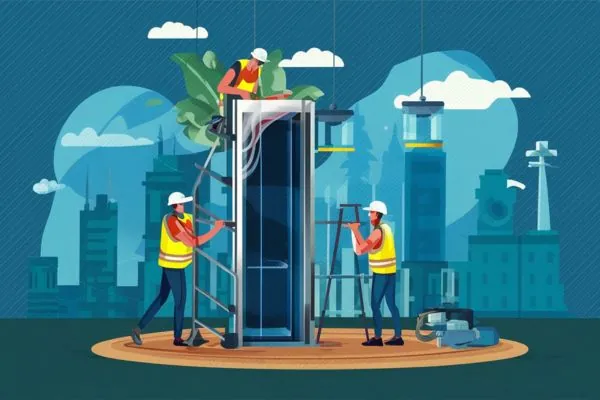Commercial elevators play a pivotal role in all buildings. They enhance accessibility and contribute significantly to the overall functionality of commercial properties by moving people from one floor to another. As businesses evolve, the need for efficient, reliable vertical transportation systems becomes more apparent. This is especially true in today’s world when properties are being reused. Malls are being converted into apartments. Medical office spaces are being converted to residential living, and some offices are being converted to residential living.
Buildings are being reused throughout the country as we evolve. This guide provides some basic information into the world of commercial elevators. It covers critical aspects from costs and dimensions to installation, repair, and maintenance. The guide aims to provide valuable insights for building owners, property managers, and decision-makers.
A Prerequisite Understanding Commercial Elevators
Commercial elevators, designed to serve the needs of buildings serving various purposes, including offices, hotels, hospitals, and retail centers, are more than just transportation systems; they invest in your property’s infrastructure and operational efficiency. Critical elements shape the landscape of commercial elevators.

Cost Considerations: An Investment Perspective
One of the first questions that comes to mind is:
How much does a commercial elevator cost?
While the initial price for installing a commercial elevator can range significantly based on size, type, and customizations, averages suggest a ballpark figure from $125,000 to over $550,000 per unit and more. The cost depends on which elevator system components are being modernized or updated.
The price for a new installation also differs and depends on various attributes. The latest installation ranges from $175,000 to over $550,000 per unit. This investment enhances building functionality. It adheres to safety standards, reliability, performance, and accessibility, potentially increasing the property’s value.
Dimensions and Capacity: Tailoring to Your Needs
The commercial size of an elevator depends on its intended use and capacity requirements. Standard dimensions accommodate 3,000 to 4,000 pounds or more and meet the demands of most commercial buildings. However, you can customize dimensions and capacity to suit specific needs, ensuring your elevator system aligns with your building’s operational requirements.
The New Installation and Modernization Process
Commercial elevator installation is a complex process that requires meticulous planning and execution. Essential steps include choosing the right contractor, understanding your building’s requirements, and complying with local codes and standards.

Moreover, modernizing existing elevators can significantly enhance their efficiency, safety, and longevity. This approach provides a better return on investment. New construction and modernization of elevators follow similar methodologies.
Maintenance and Repair: Ensuring Long-Term Reliability
Regular elevator maintenance and timely repairs are crucial for the longevity and reliability of commercial elevators. A well-maintained elevator not only ensures the safety of its users but also minimizes downtime. It prevents potential revenue loss, frustrated tenants or users, and overall unnecessary elevator issues.
Engaging with a qualified, reputable elevator service provider can streamline maintenance processes, reduce operational costs, and prolong the lifespan of your elevators. It is the building’s responsibility to ensure the elevator’s maintenance is completed. The guidelines for elevators are as follows: in ASME A17.1 and others.
Choosing the Right Elevator: Factors to Consider
When selecting an elevator for commercial use, whether upgrading, modernizing an existing elevator, or new construction, consider the building’s size, the average number of users, usage, traffic flow, energy efficiency, and the level of customization required.
Whether traction elevators for high-rise buildings or hydraulic models for lower floors are the right choice, it depends on your needs and budget constraints. Proprietary elevators and non-proprietary elevator systems should also be considered. An elevator consultant can assist any building with this decision process. They can explain its pros and cons.
When considering installing a new elevator in new construction or completing an elevator modernization, integrating a commercial elevator system into your property requires thorough planning, investment, and ongoing management.
By understanding the essentials of commercial elevators, you can make informed decisions that enhance your building’s value, safety, reliability, and operational efficiency. This process can be expensive, and ensuring you have all the correct information is critical.
Have a Question About Elevators?
Talk to a Professional Elevator Consultant
FAQ About commercial elevator dimensions Answered
What is a commercial size elevator?
Commercial elevators typically range in size and capacity. They are designed to accommodate the specific needs of a commercial building, including passenger, service, and freight requirements. Commercial elevators can be customized based on the application needed as well.
Which elevators are best for commercial use?
Traction elevators are preferred for high-rise commercial buildings due to their speed and efficiency, while hydraulic elevators are suitable for smaller buildings with fewer floors. It really depends on the requirements of the building.
What is the standard size of elevator for a commercial building in capacity?
Standard commercial elevators can carry between 3,000 to 4,000 pounds or larger, suitable for the majority of commercial applications.
How much can a commercial elevator hold?
Depending on its design and purpose, a commercial elevator can hold several pounds, addressing the needs of both passengers, service and freight.
